Elements to look for in a Japanese Garden:
Rocks – used in many ways in gardens. They can symbolise mountains, rugged sea scapes. Smooth rocks are often used as stepping stones. Rocks are classified by shape and arranged in groups of 2, 3 5, or 7, of these, groups of 3 are the most common
 A group of 3 rocks surrounded by raked sand – Ryoan-ji
A group of 3 rocks surrounded by raked sand – Ryoan-jiSand and Gravel - are used in gardens that are designed to be viewed from outside and not walked on. The choice of particle size is important as it must be big enough not to blow away but small enough to raked.
In Zen Gardens the raked patterns represents flowing water and contrast the solidity of the rocks.
The colour is also important, white sand represents purity whilst grey, brown and blue/black sand represents tranquillity.
Raked sand representing waves.
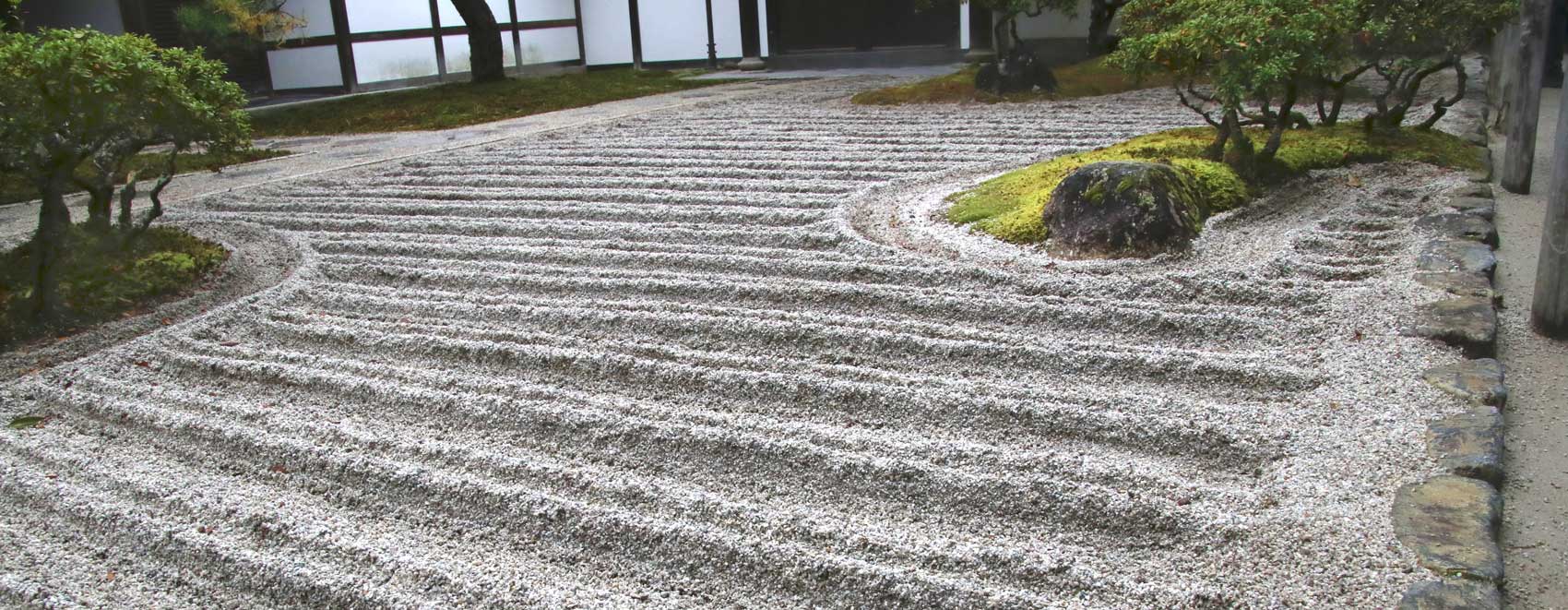 Raked Sand - Ginkaku-ji Garden
Raked Sand - Ginkaku-ji GardenPonds, streams and waterfalls – central element represents real or mythical lakes or seas. Often carp living in the ponds add colour to the garden.
 Waterfall - Himeji Koko-en Gardens
Waterfall - Himeji Koko-en Gardens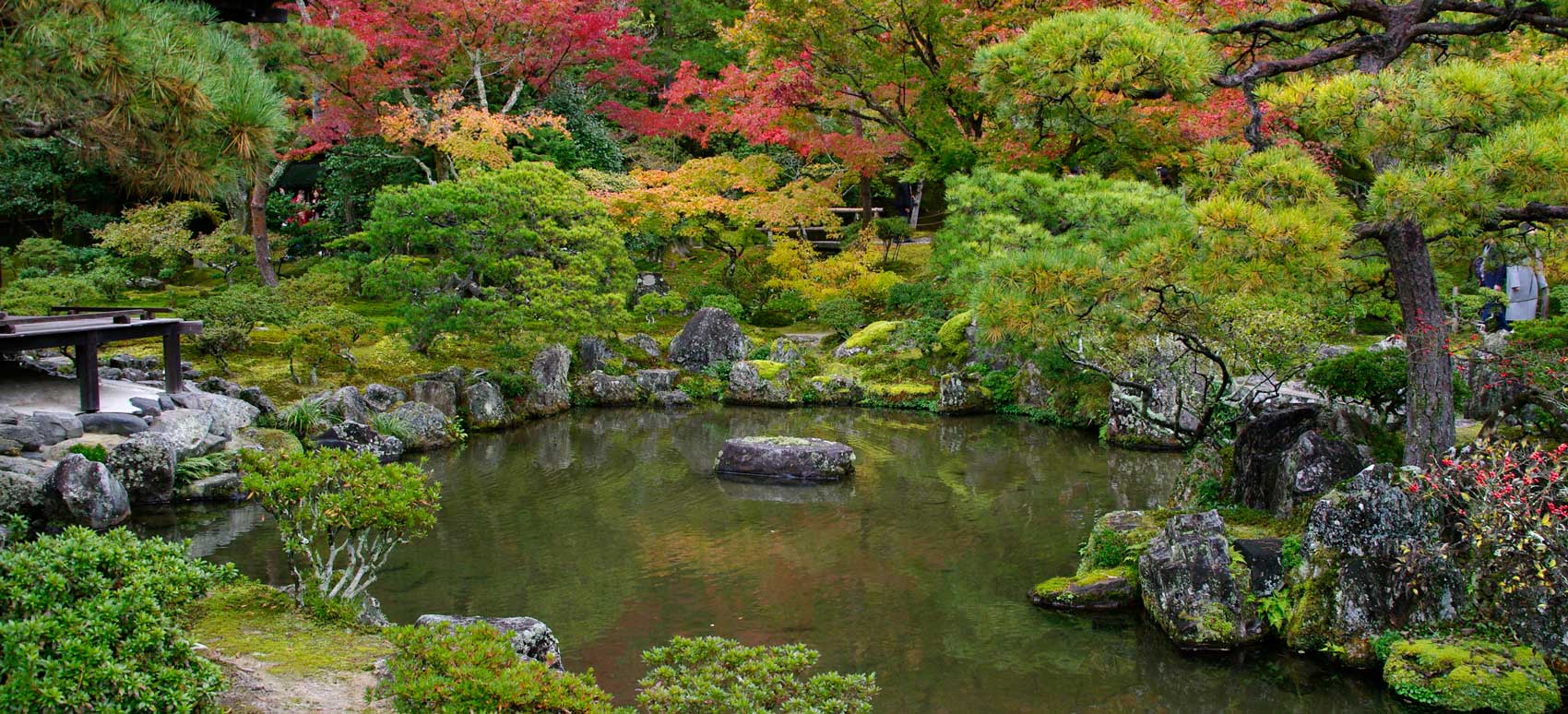 Ginkaku-ji Gardens - stream fed pond
Ginkaku-ji Gardens - stream fed pondIslands – often represent real islands or have religious symbolism.
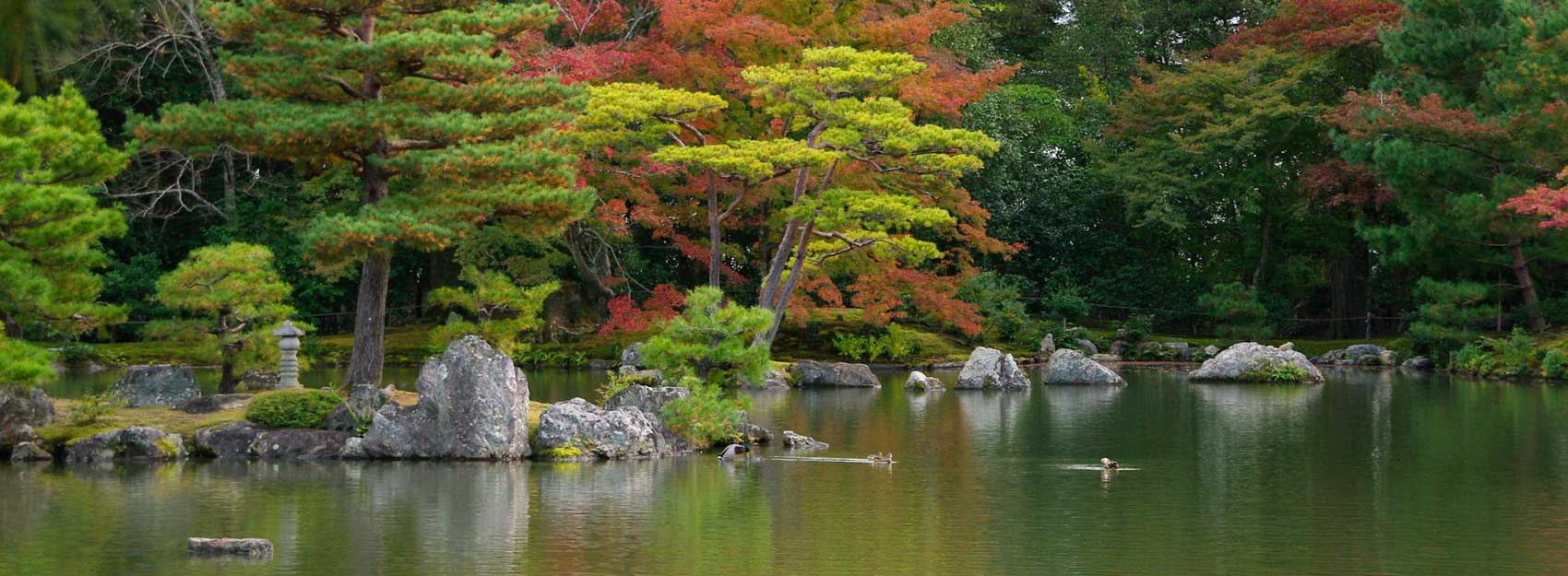 Small islands, some large enough for a tree. Kinkaku-ji
Small islands, some large enough for a tree. Kinkaku-jiBridges – a common feature of Japanese gardens used to connect islands within the garden. They are made of stone or wood with a range of designs from very simple to extremely complex.
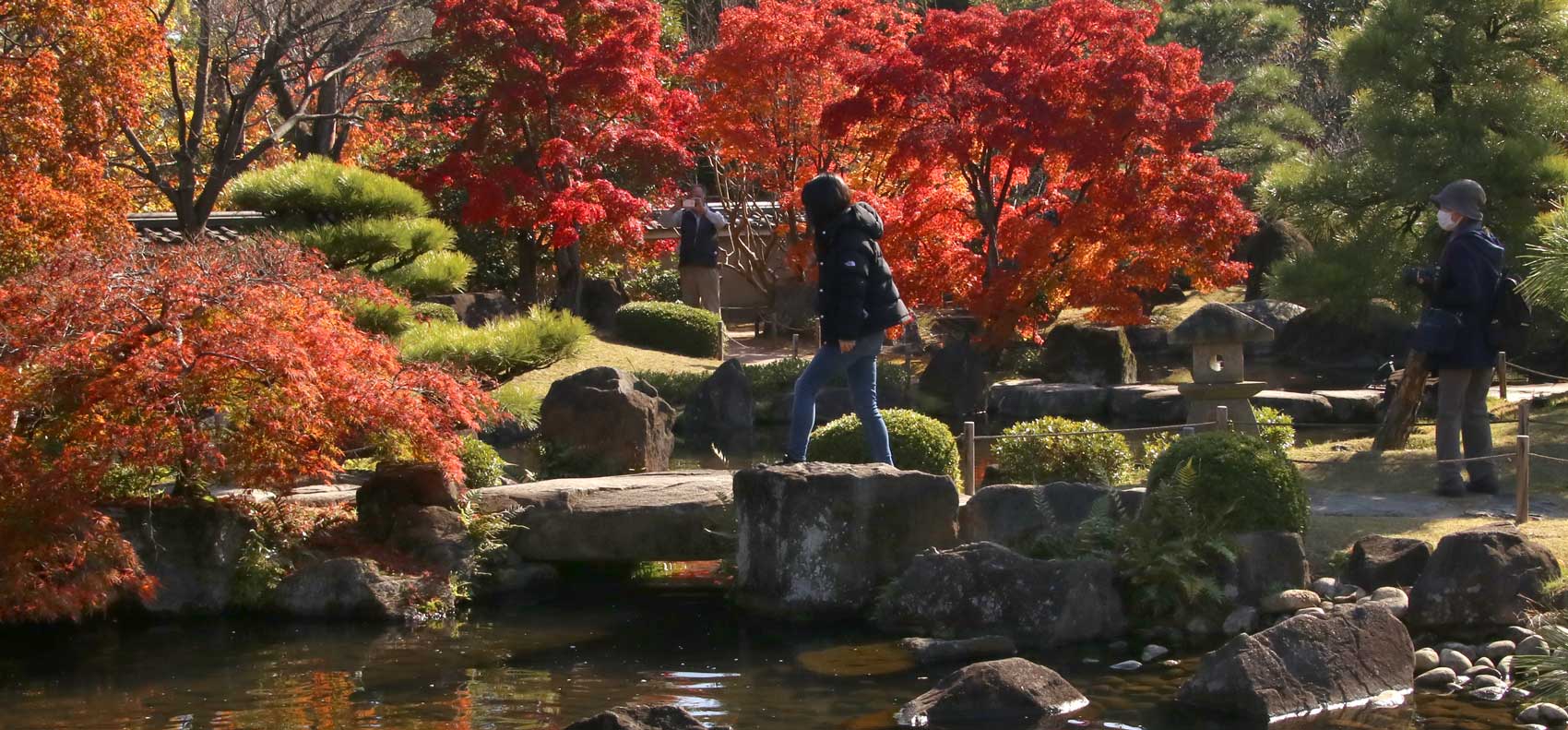 Himeji-Kokoen Gardens, One-Slab Stone Bridge
Himeji-Kokoen Gardens, One-Slab Stone Bridge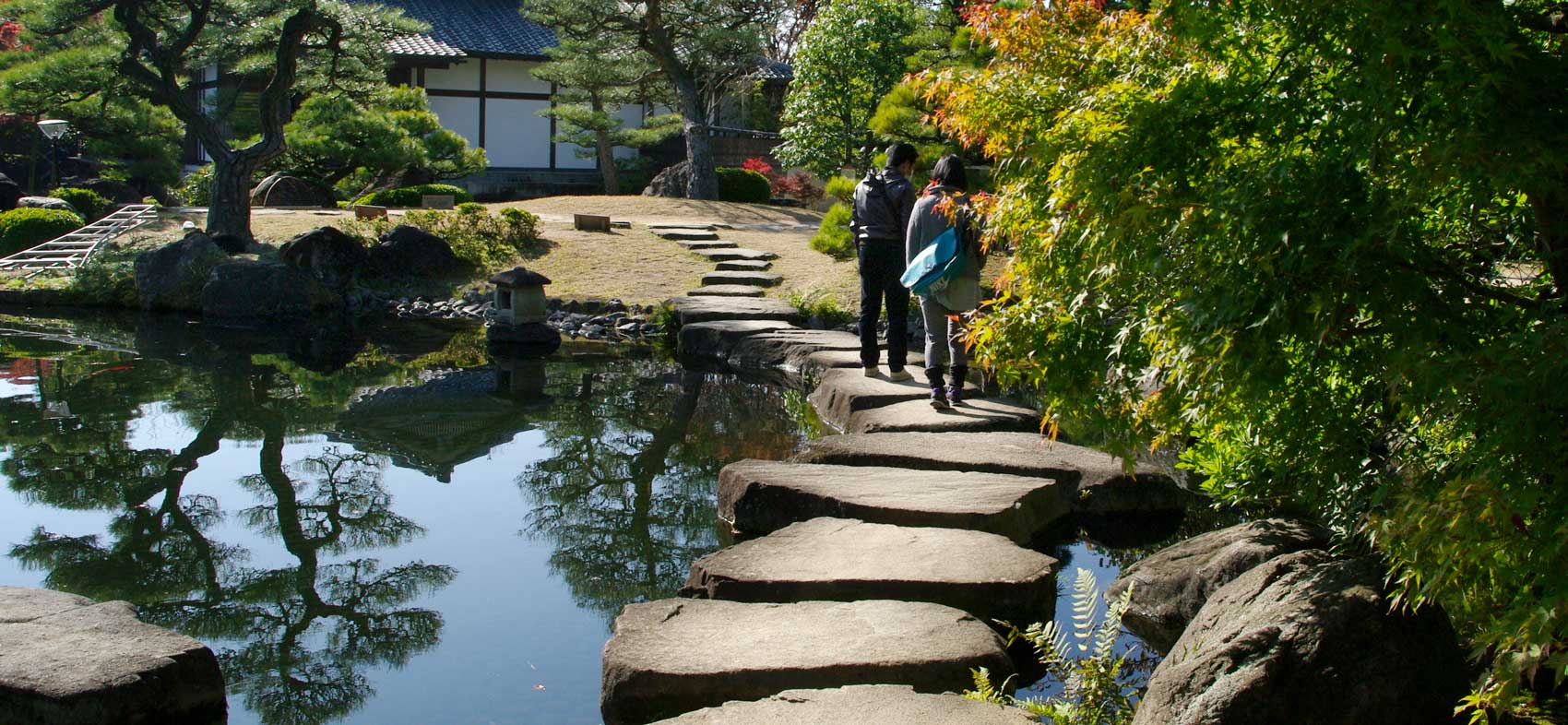 Smooth stones used as stepping stone bridge, Hemi-ji – Garden of Lords Residence
Smooth stones used as stepping stone bridge, Hemi-ji – Garden of Lords Residence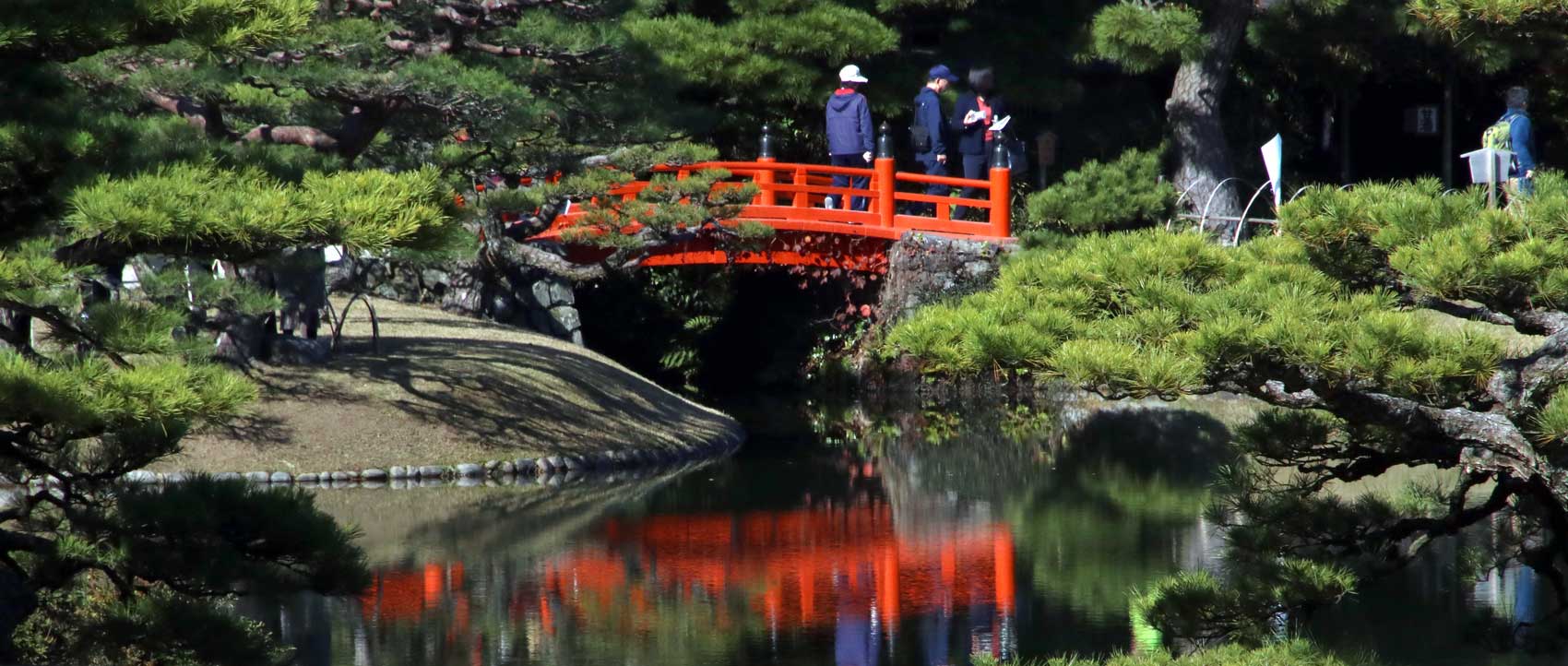 Painted arched bridge – Ritsurin Gardens
Painted arched bridge – Ritsurin Gardens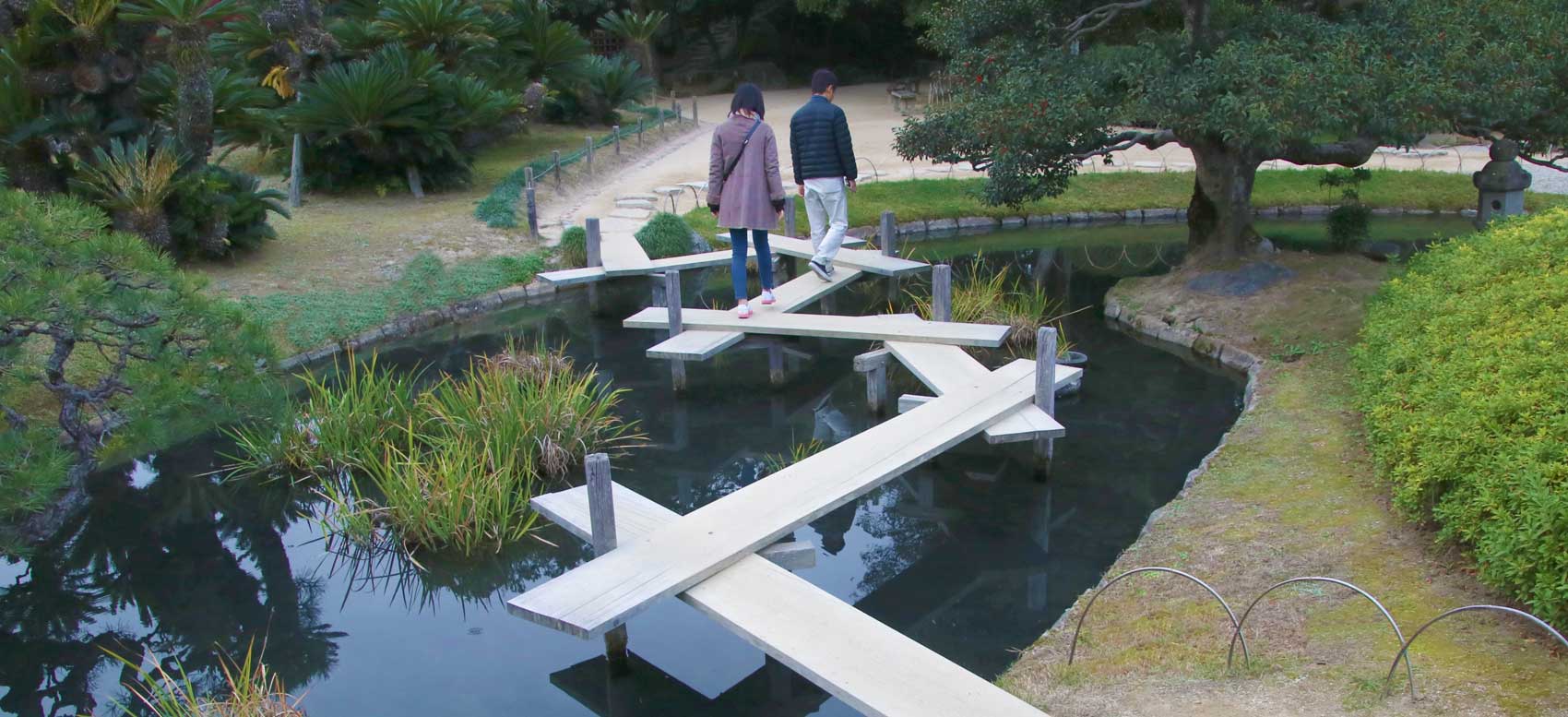 Wooden Zig-Zag Bridge – Korakuen Gardens
Wooden Zig-Zag Bridge – Korakuen GardensLanterns - tend to be made of stone and placed in carefully chosen locations, they are used to give light and as a garden decoration.
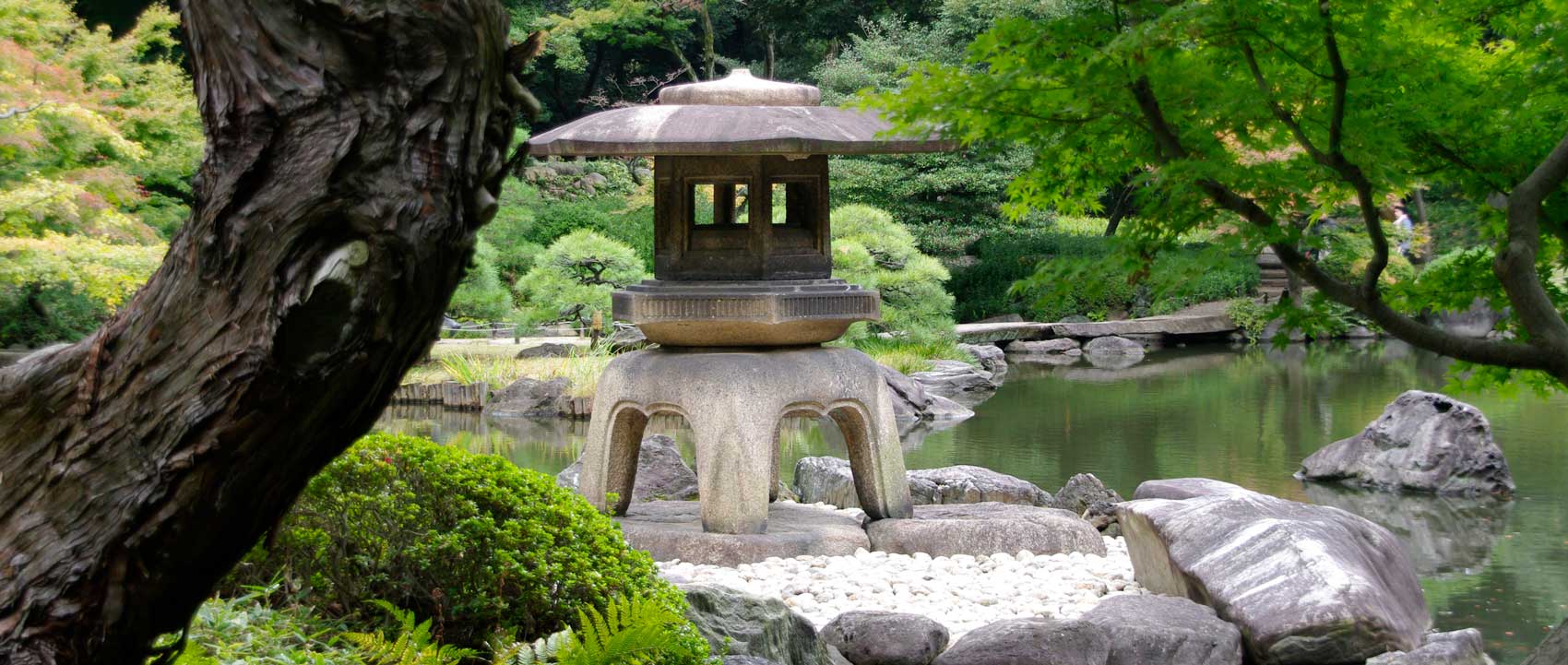 Snow Lantern – have legs and a wide roof – Kyu Furakawa Gardens Tokyo
Snow Lantern – have legs and a wide roof – Kyu Furakawa Gardens Tokyo Lantern with pedestal and no base – wide roof because of snow – Shoyoen, Nikko
Lantern with pedestal and no base – wide roof because of snow – Shoyoen, Nikko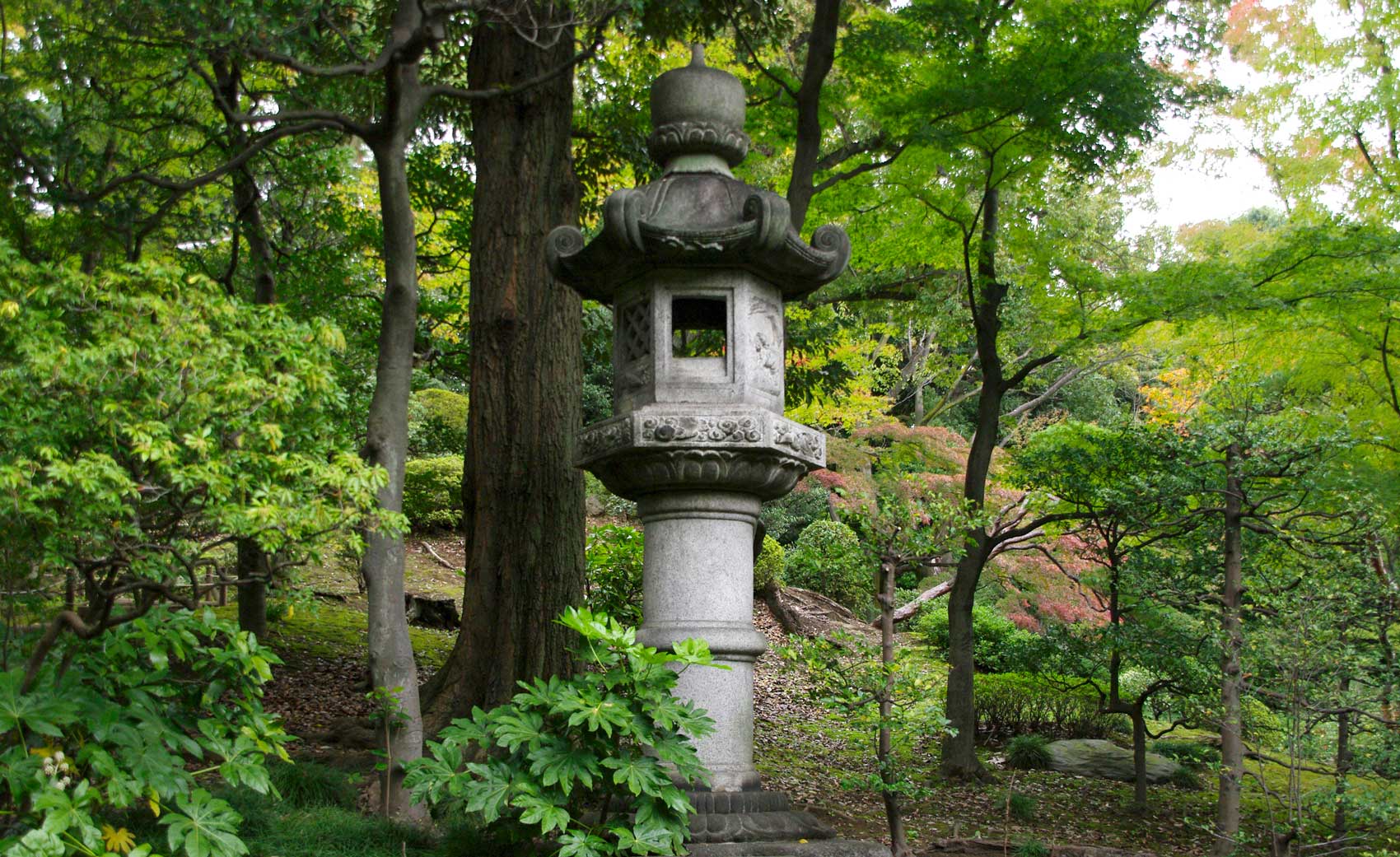 Ornate Stone lantern with pedestal and base - Kyu Furukawa Gardens Tokyo
Ornate Stone lantern with pedestal and base - Kyu Furukawa Gardens Tokyo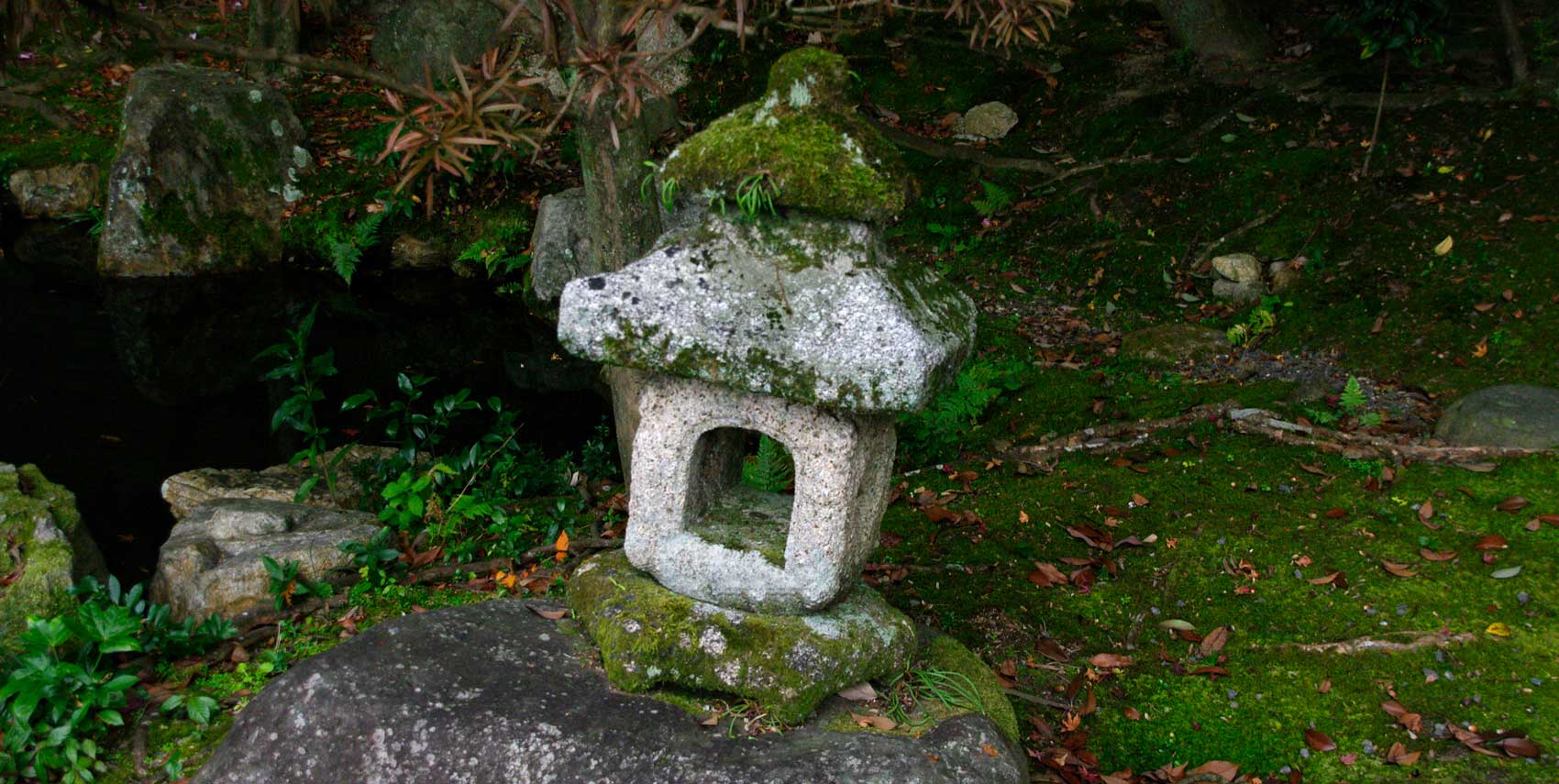 Simple stone lantern without pedestal – Tea house Kyoto
Simple stone lantern without pedestal – Tea house KyotoWater Basins - were originally part of tea ceremonies now they tend to be more ornamental and often placed next to a lantern.
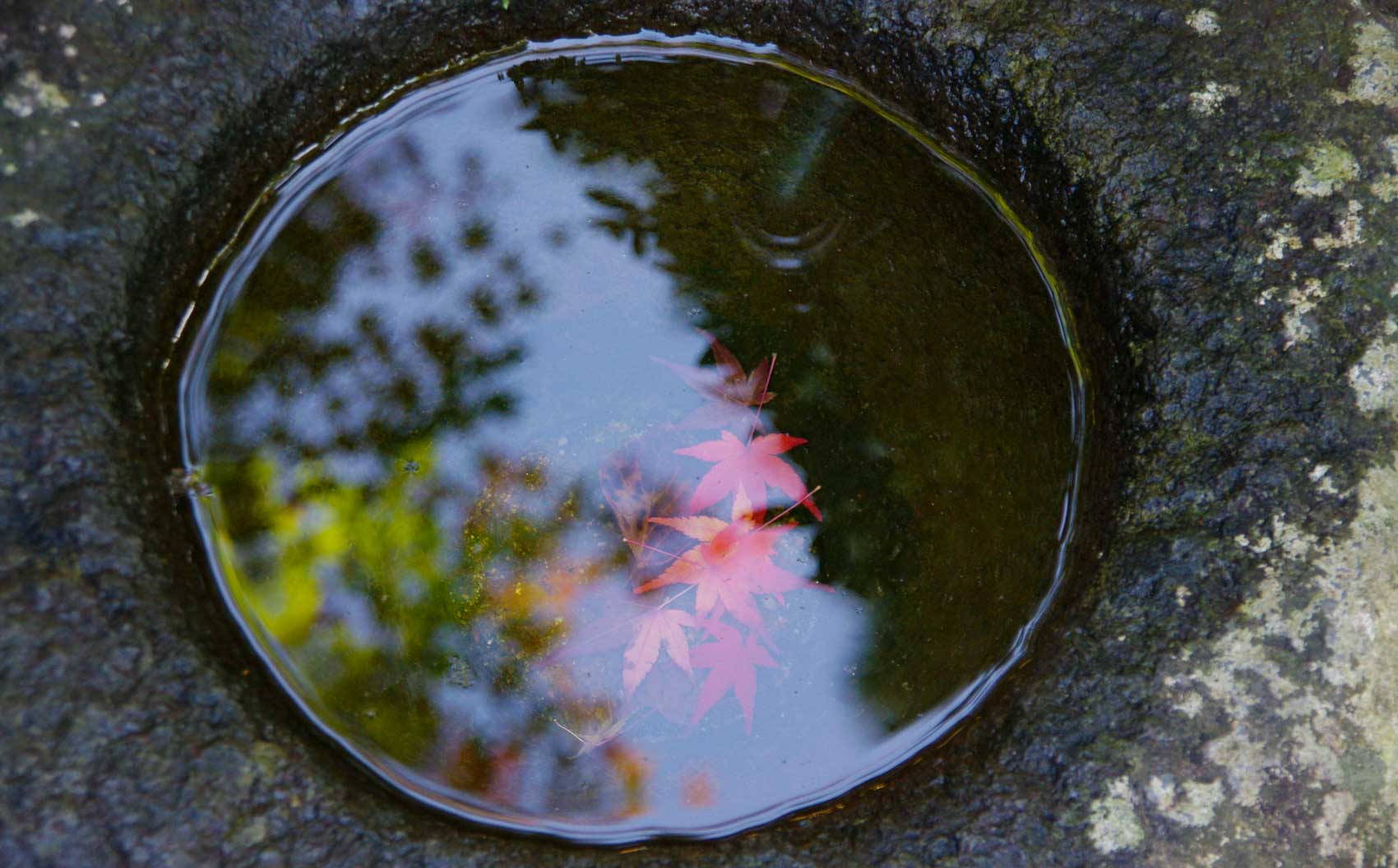 Simple stone water basin - Himeji
Simple stone water basin - Himeji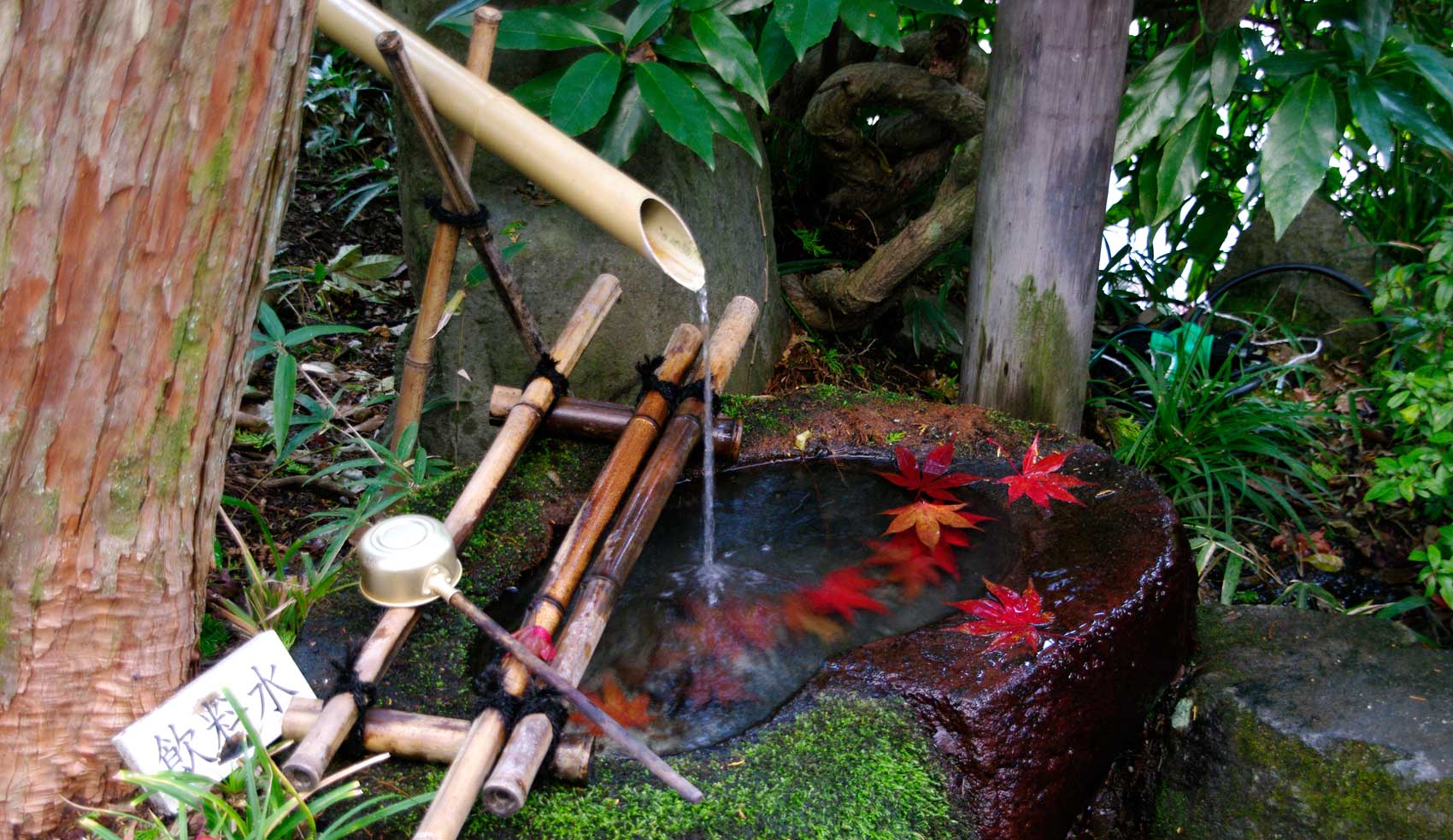 Water enters the basin through a bamboo pipe. Stone water basin Shoyoen, Nikko
Water enters the basin through a bamboo pipe. Stone water basin Shoyoen, Nikko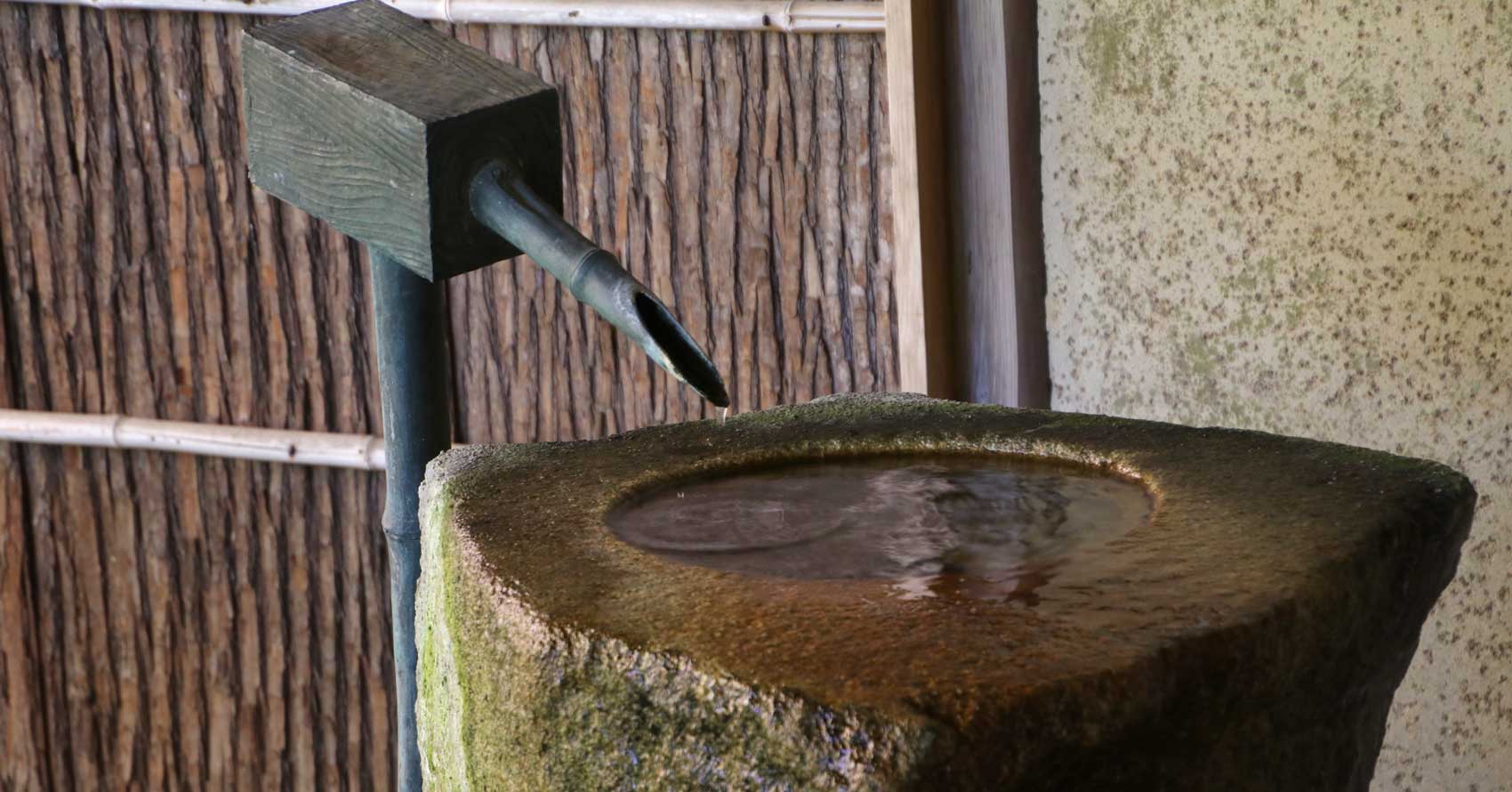 A tall stone water basin, water entering through pipe – Yoshikien Garden Nara
A tall stone water basin, water entering through pipe – Yoshikien Garden NaraPaths – are an integral part of landscaped or strolling gardens. The paths take visitors to all the special parts of the garden via a carefully chosen route that hides and then reveals views.
Paths are made of beaten earth and are either left bare or covered with gravel or stones of various sizes.
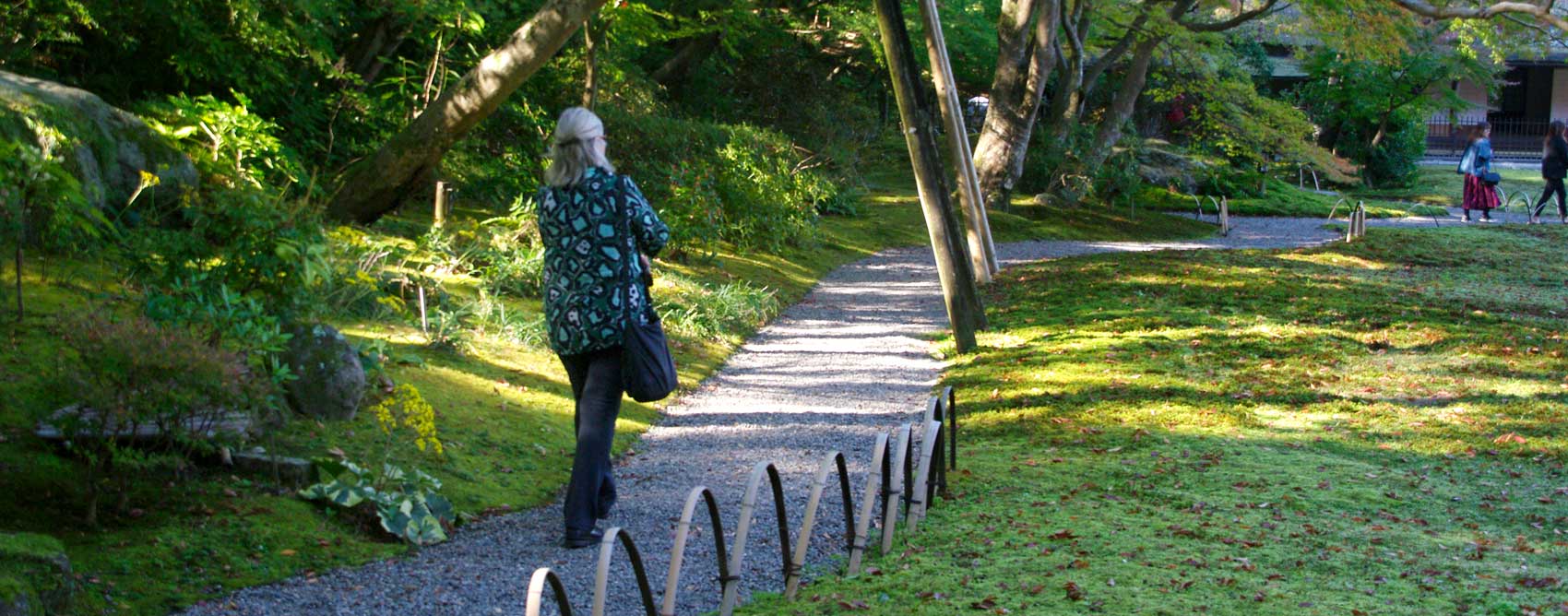 Gravel path – Yoshikien Garden
Gravel path – Yoshikien Garden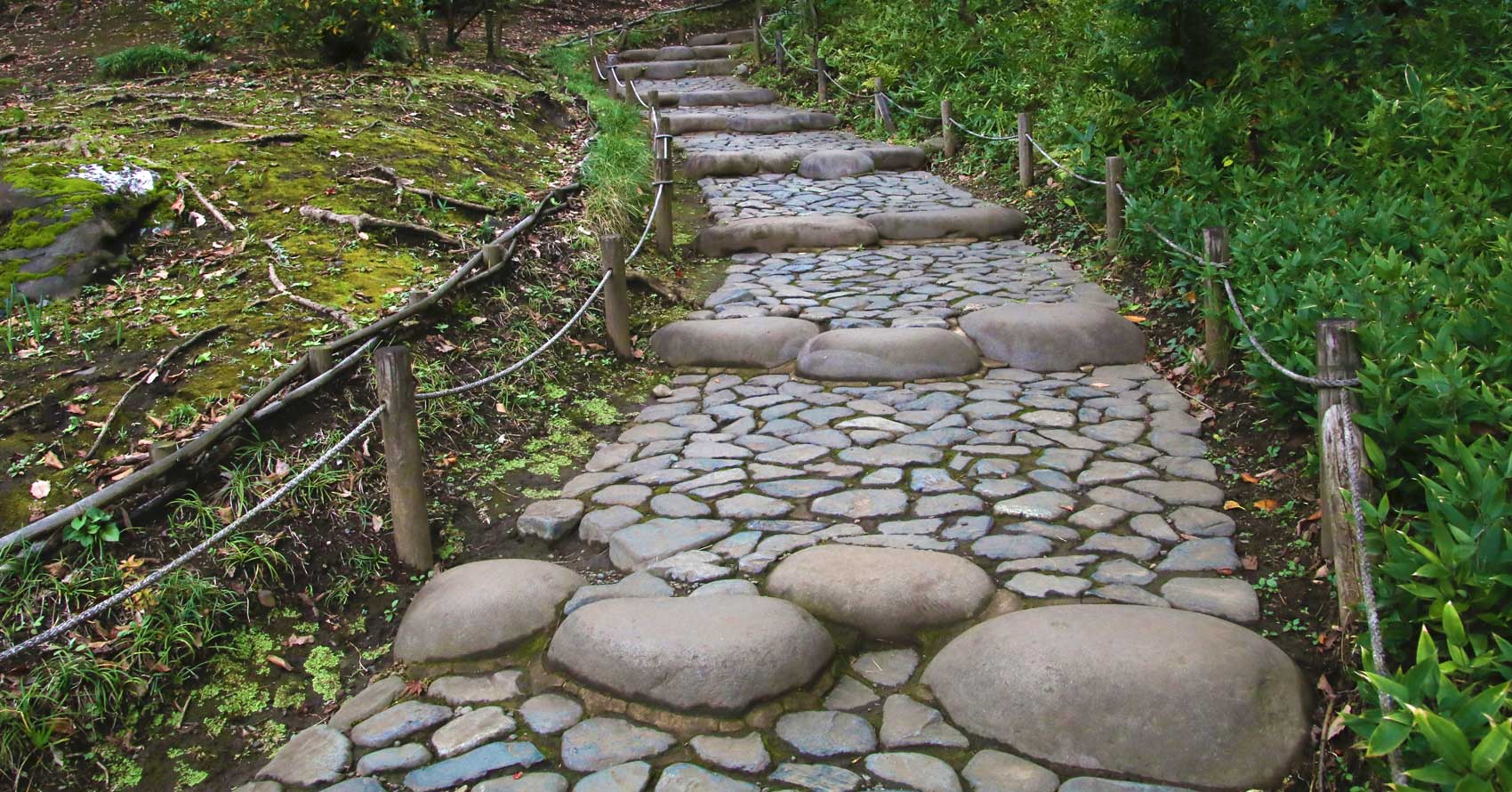 Path of mixed size stones – Kyu Furakawa Gardens Tokyo
Path of mixed size stones – Kyu Furakawa Gardens Tokyo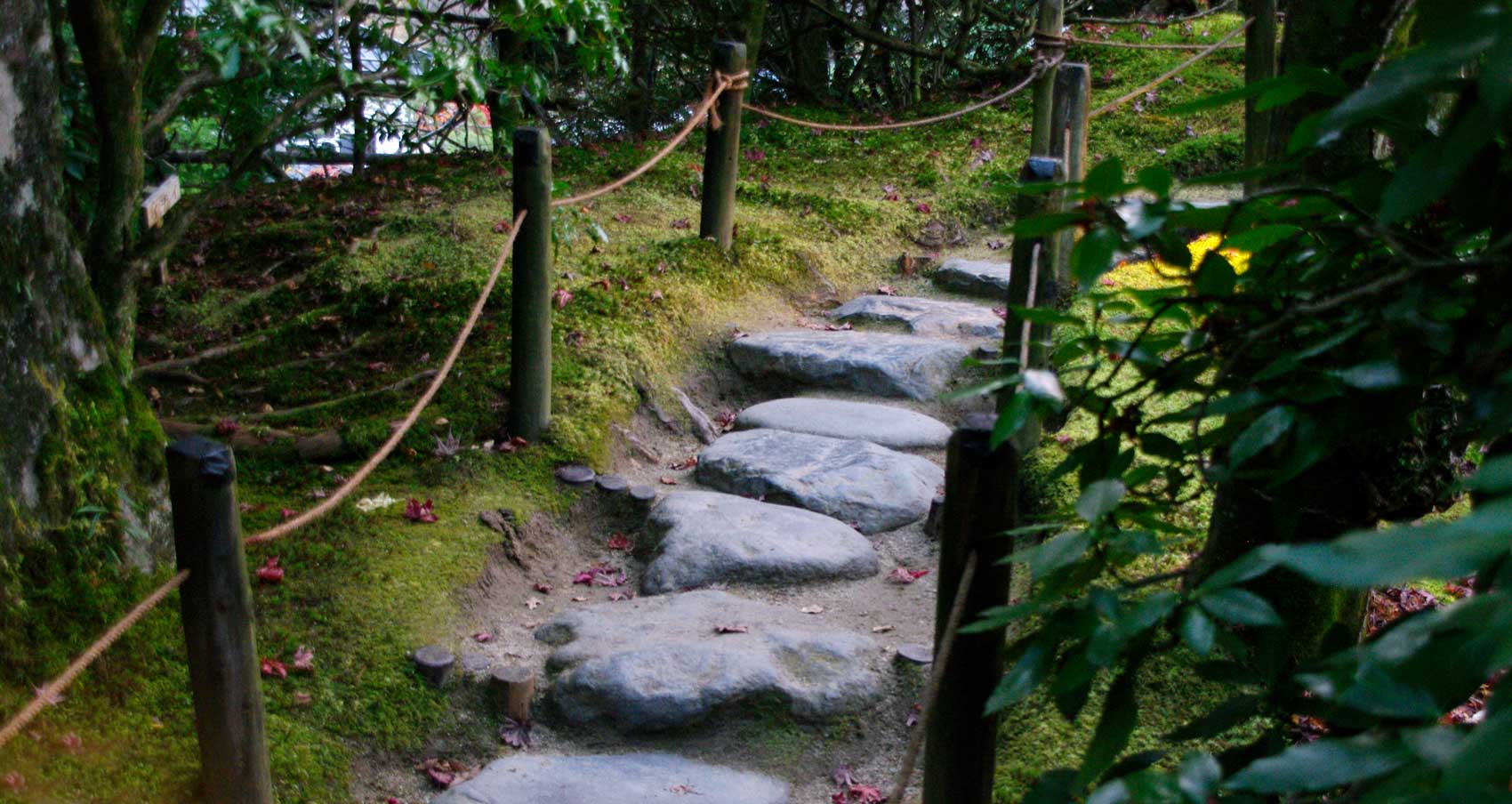 Large smooth stones placed on beaten earth – Shoyoen Gardens
Large smooth stones placed on beaten earth – Shoyoen GardensFences and Walls – Are an important part of garden design. They not only enclose the garden but screen unsightly areas and frame features within the garden
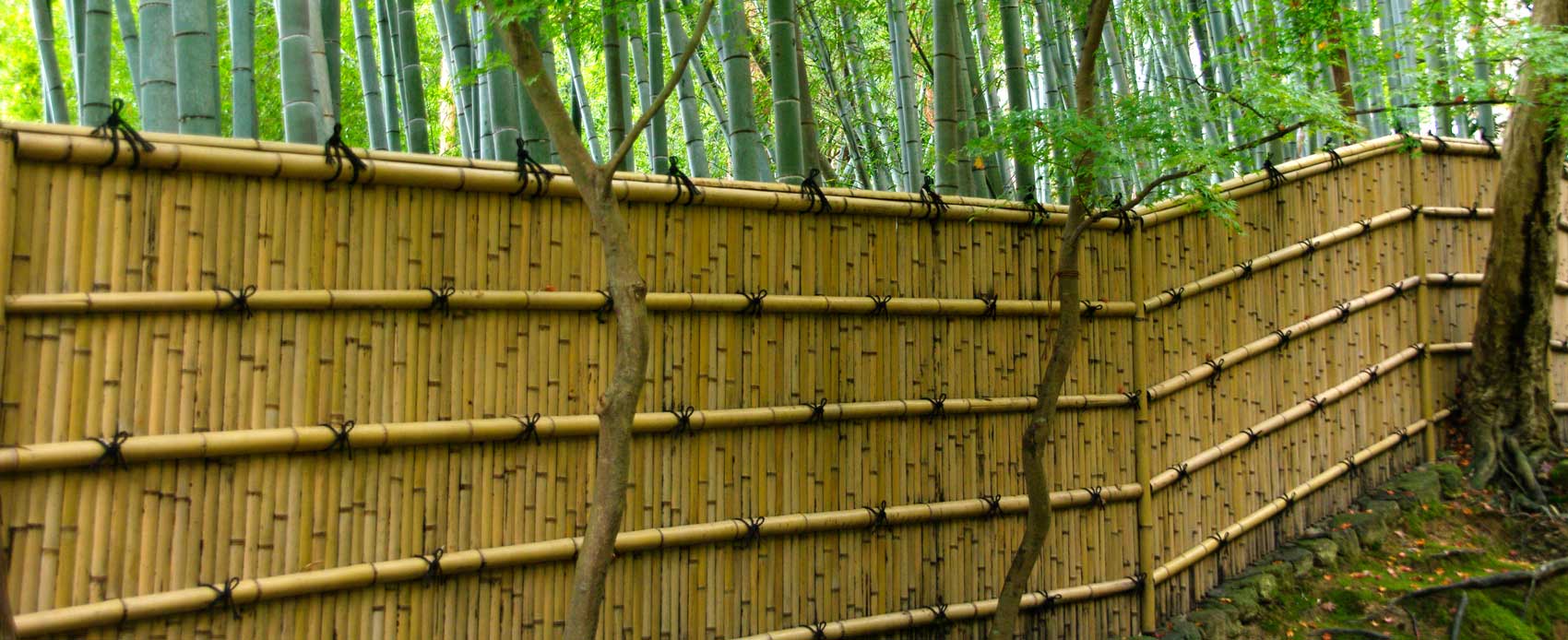 Bamboo fence divides the Bamboo Forest from Gingkaku
Bamboo fence divides the Bamboo Forest from Gingkaku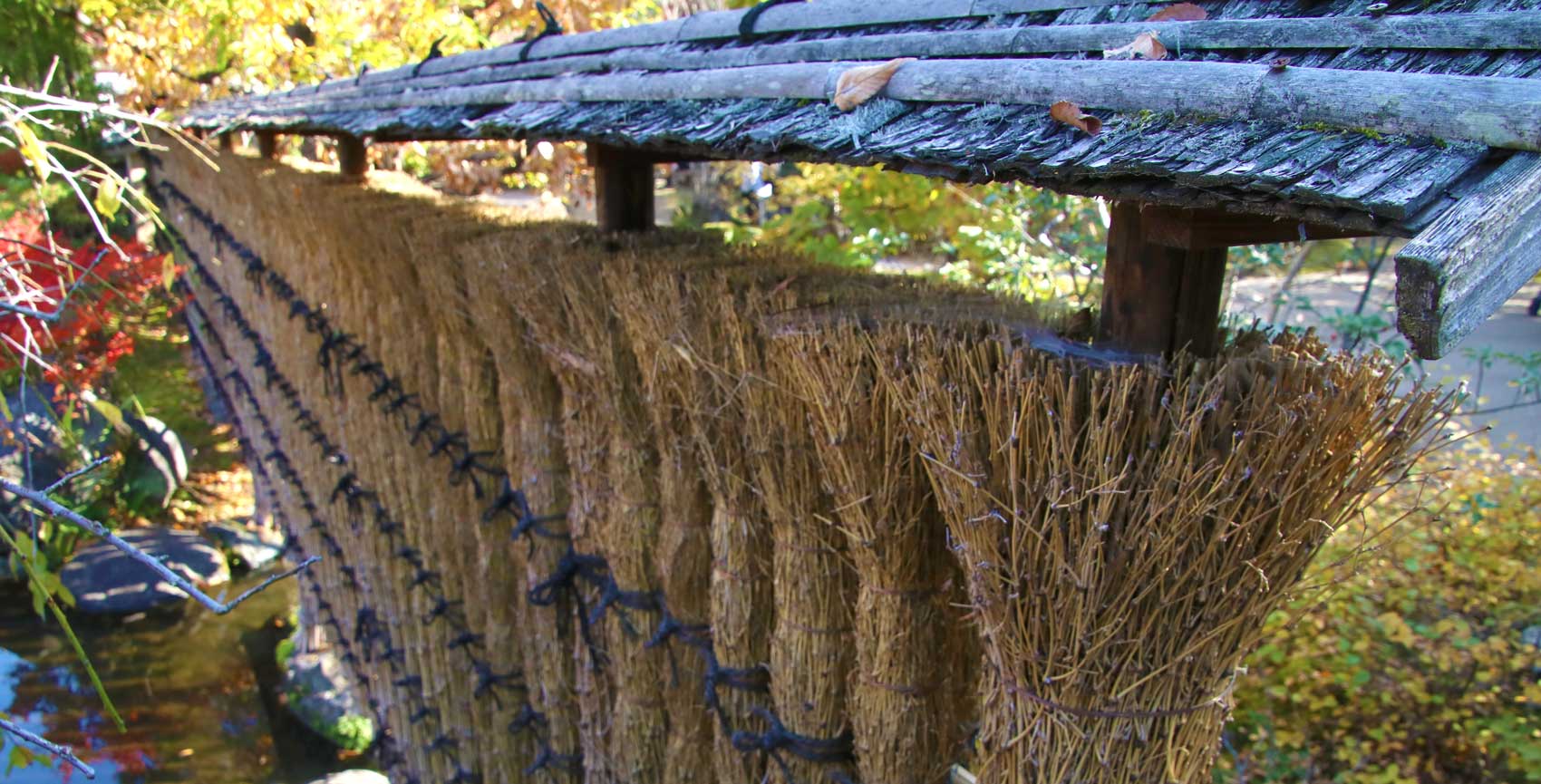 Fence of bundled young bamboo stems divides two of the nine gardens in Himeji.
Fence of bundled young bamboo stems divides two of the nine gardens in Himeji.Plants are also seen as symbols, they are placed carefully with space around them to emphasize individual qualities.
The evergreen plants most commonly used are Pines, Conifers and Korean Box, these are often pruned to emphasize and exaggerate their shape. Young plants are trained with wires to create the desired shape. Cloud pruning is very popular in Japan.
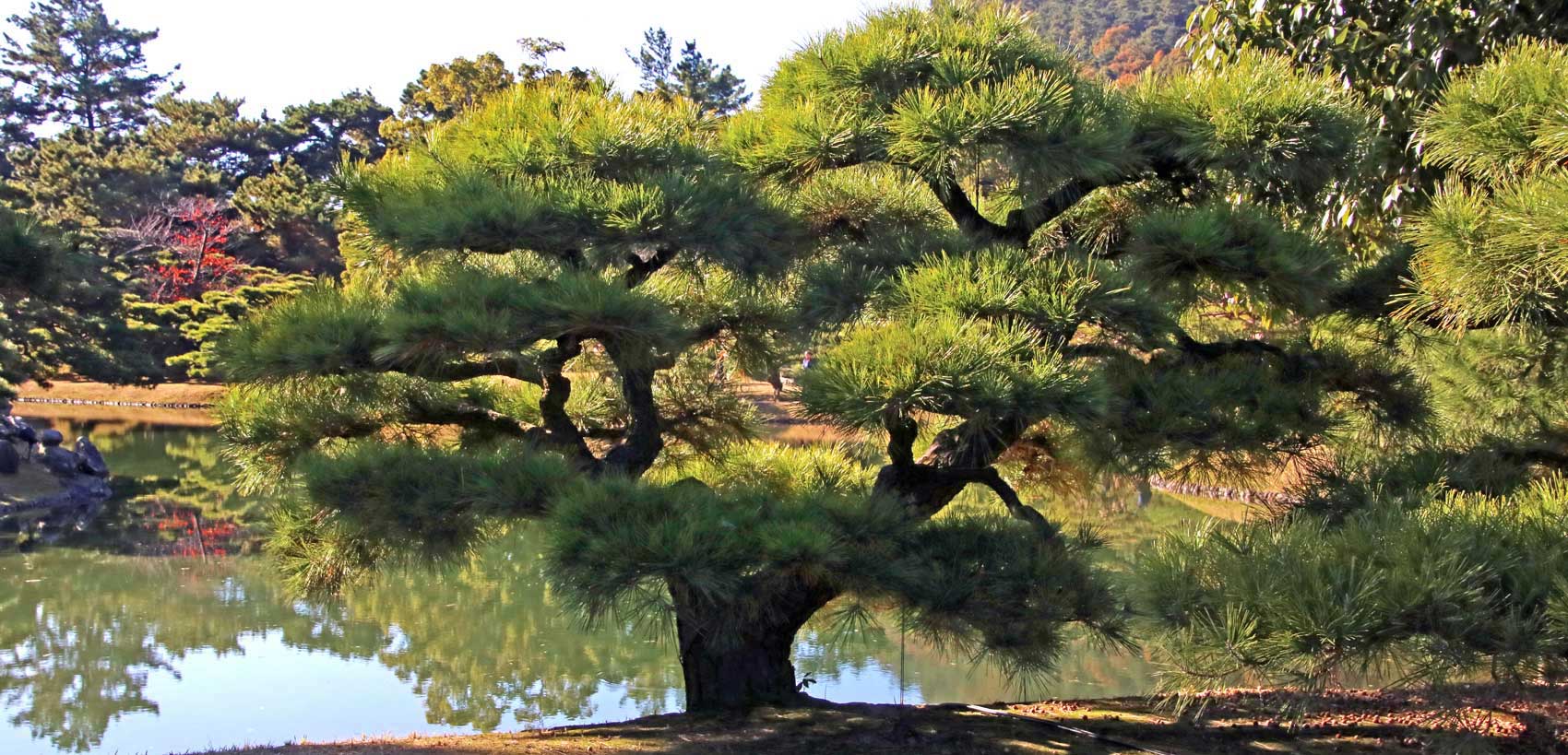 Cloud Pruned Black Pine
Cloud Pruned Black PineBut of course it is the Acers, or Maples that are most associated with japanese Gardens, especially in Autumn when they are quite spectacular.
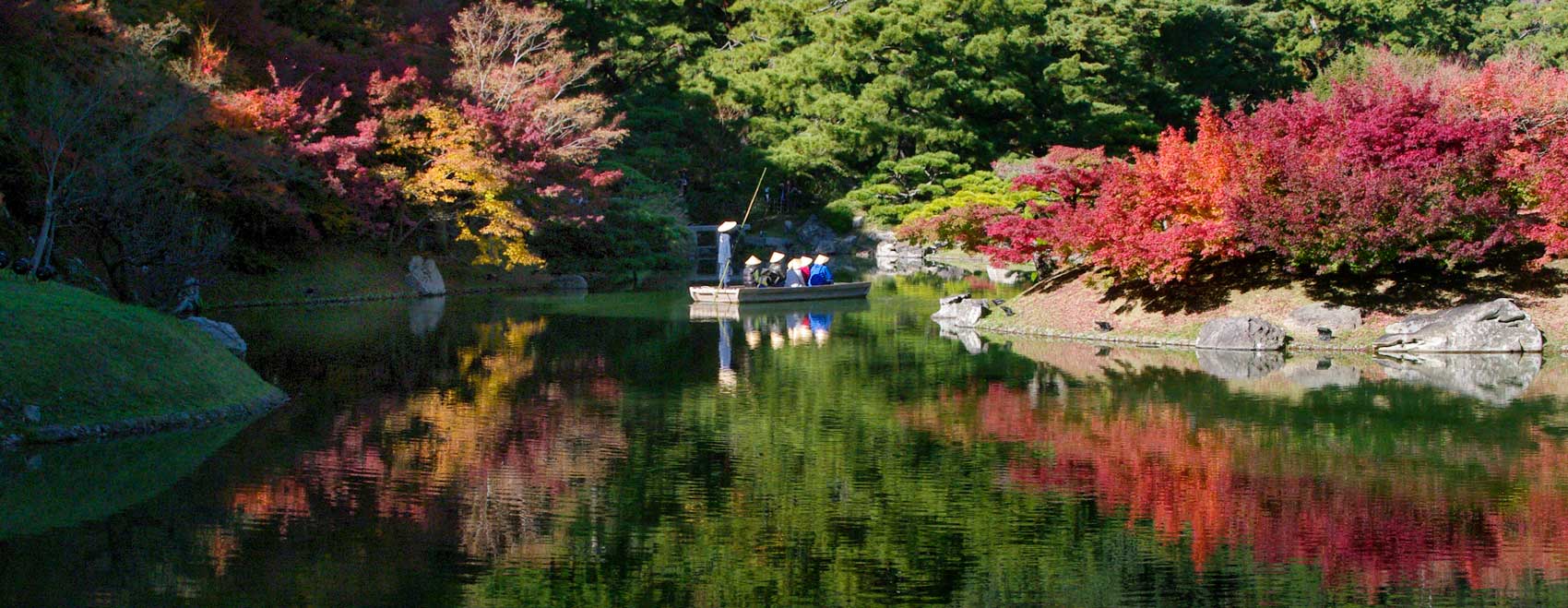 Autumn colour at its best at Ritsurin
Autumn colour at its best at RitsurinJapan has a high rain fall, gardens tend to be damp so that moss grows very well here. It is used as an integral part of all gardens, adding colour as it grows over rocks, buildings and stone features.
In some gardens it is the main feature, as at Hakone Moss Garden.
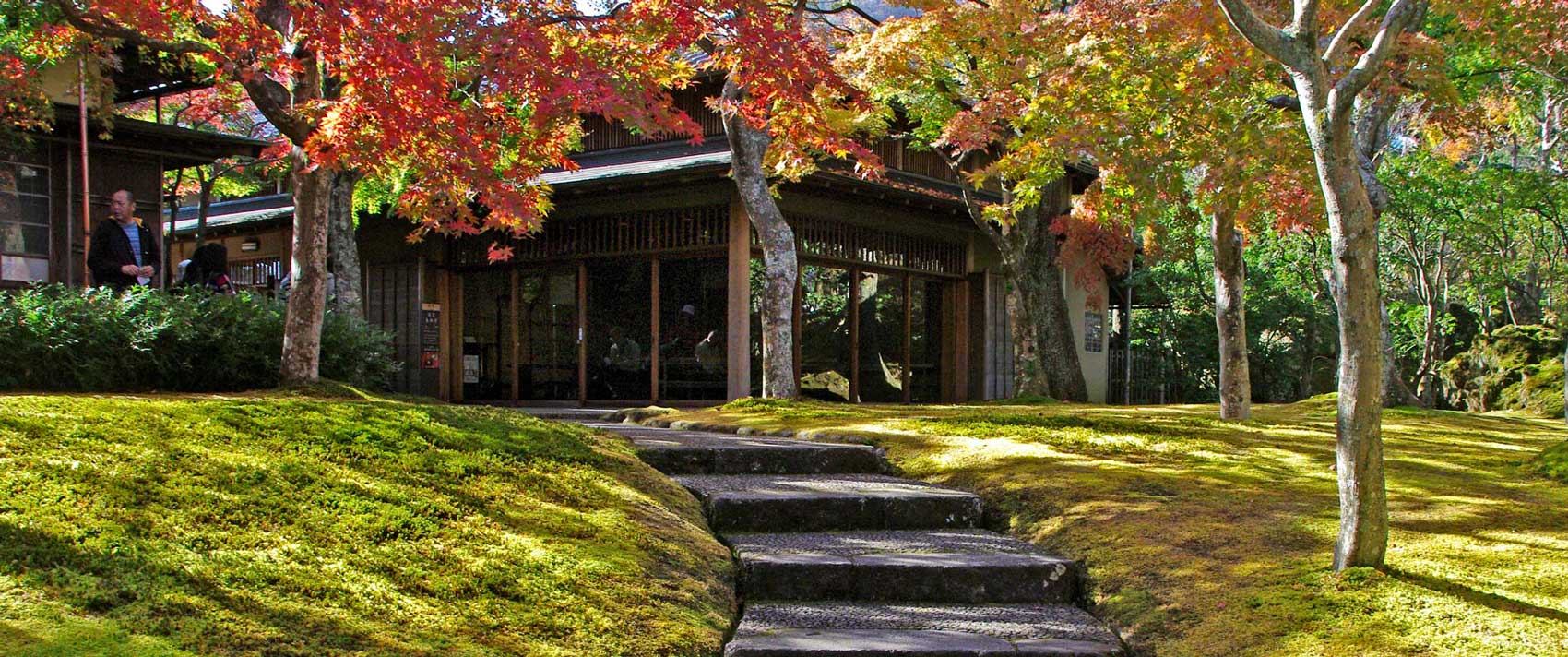 Hakone Moss Garden
Hakone Moss Garden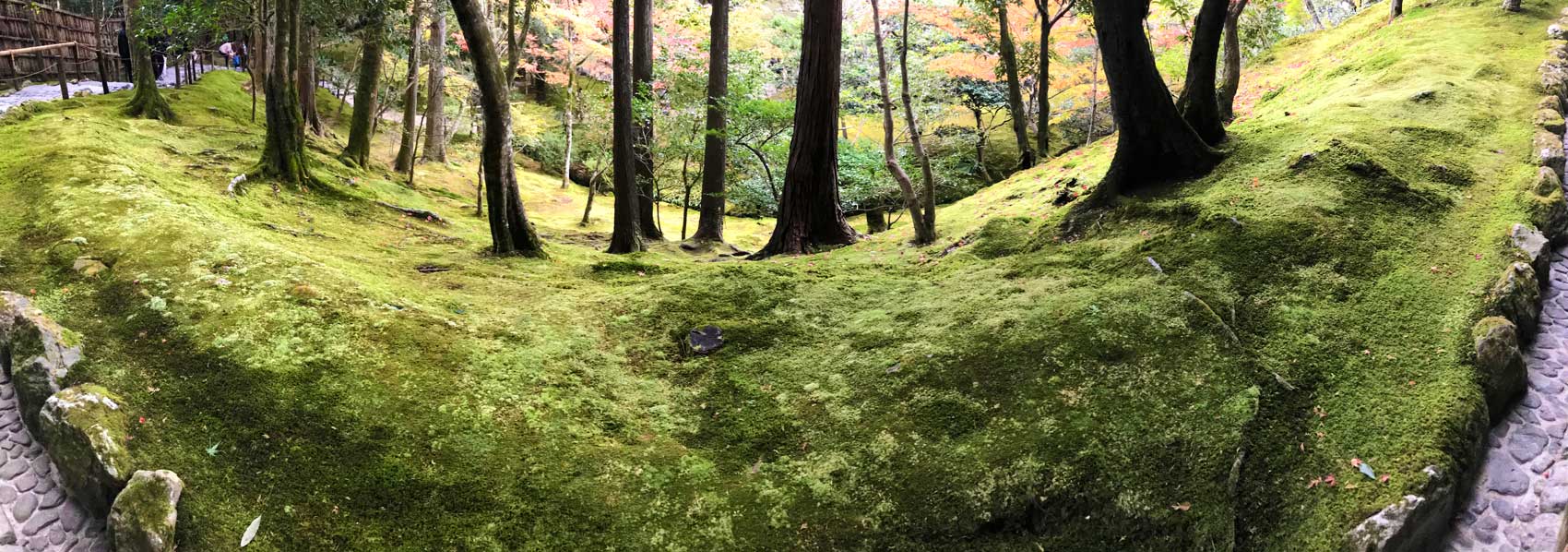 Woodland floor completely covered in moss - Gingkaku-ji, Kyoto
Woodland floor completely covered in moss - Gingkaku-ji, KyotoFlowering plants are chosen for their seasonal colour.
Cherry trees are chosen for their wonderful display of Spring blossom while Maples, Chrysanthemum, Miscanthus and sometimes Dahlia are selected for their autumn colour.
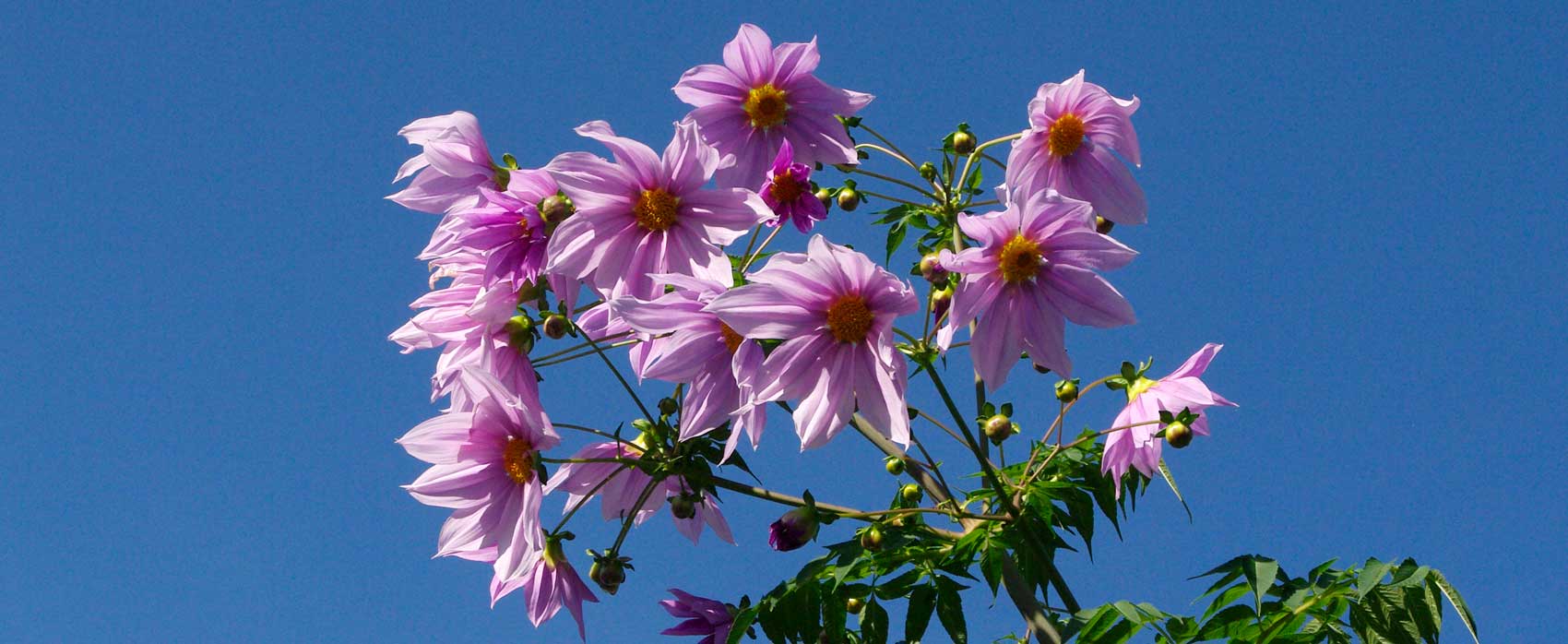 Autumn flowering Dahlia imperialis - a rare but welcome sight
Autumn flowering Dahlia imperialis - a rare but welcome sightPines and bamboos are planted to give colour and interest to the garden during the winter months.
 Bamboo at Tenryuji Temple, Kyoto
Bamboo at Tenryuji Temple, KyotoJapanese gardens are high maintenance, the gravel needs grooming every day (part of the spiritual meditation) and the shrubs and trees need pruning regularly.
In some cases elaborate wooden support scaffolding is erected under tree branches to support them in their desired shape. Old trees seem to be revered as much as old humans.

To increase the illusion of the garden size, Japanese garden designers have used many tricks to alter perspectives. They plant tall bright trees with large leaves at the front and small trees with dark fine leaves at the back, this tricks the brain into thinking the distance from front to back is much further than it is.
Borrowed views (as also seen in English Landscape designs) use structures either natural or man-made to provide a focal point outside of the garden when viewed from inside the garden. The affect of these is to increase the depth of vision and make the garden seem much bigger than it actually is.
Miniaturisation is also very popular, rocks, lakes and hills used to represent real landscapes.
 Miniature Rock Garden - Ryoanji
Miniature Rock Garden - RyoanjiAll in all it takes time to adjust to the Japanese style of gardens, but when you do it becomes very rewarding.
It's an entirely different focal point - by optically and spiritually.